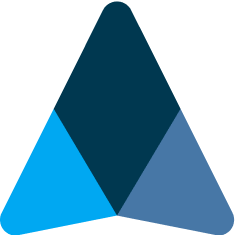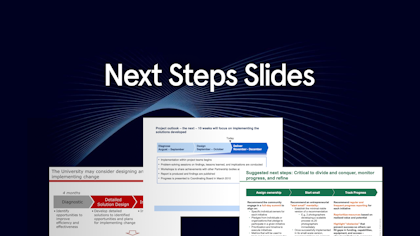The point of any consulting project is to solve a problem and provide a clear direction forward for stakeholders to act on the solution. Although the lion’s share of any project will be spent on data gathering and analysis, the most important part of the final project report will be the recommended solution and actions or plan. This part often comes in the form of overall recommendations followed by concrete plans and steps.
In a previous blog post, we went over what a Recommendations slide is and how it is different from a Next Steps slide. In this post, we’ll dive into the Next Steps slide, why it’s important, and how to write one. We’ll also provide you with examples of Next Steps slides from McKinsey, BCG, and Bain, as well as a free template for you to create your own Next Steps slide.
What is a Next Steps slide?
A Next Steps slide most often comes at the very end of a main presentation or project report. It outlines the immediate next steps that must be taken to start implementing the recommendations outlined in the presentation.
Next Steps slides are sometimes confused with Recommendation slides. However, the two are actually quite different.
A Recommendations slide contains the overall conclusions and actions that come out of the project. These recommendations often include both short and long term action items and are the total summary to achieve the goal/solve the problem that the project set out to do.
Below is an example from a BCG project where you can see the overall Recommendations slide followed by immediate next steps:
A Next Steps slide typically focuses on the smaller to-dos that can be started tomorrow to start implementing a plan or moving the project forward. A good way to distinguish between the two is to think of them as answering two different types of questions:
- Recommendation slide: What do we need to do to achieve our goal(s)?
- Next steps slide: What do we need to do on Monday to start taking actions on those recommendations?
The Recommendations and Next Steps slides are part of the conclusion part of any project. Typically, this section starts off with the overall recommendations that represent the “answer” to the project. This is followed by a project plan that lays out a timeline and detailed initiatives to implement those recommendations, and then the section closes out with immediate next steps.
To make it confusing, this last section is sometimes called “Next Steps” as a whole. However, the actual slides follow the structure outlined above and are the best-practice way to write a section like that.
Why is a Next Steps slide important?
A Next Steps slide is important because it allows you or your stakeholders and clients to immediately start taking action.
The point of most McKinsey, BCG, or Bain projects are to uncover the root causes of a problem or explore areas of an opportunity, decide which causes and issues or areas should be addressed, lay out how they should be addressed, and make it as easy as possible for the client to then address them (either on their own or with the assistance of consultants).
A Next Steps slide is part of making it easy to move forward. It translates high-level recommendations and overall plans into actionable items.
How to write a Next Steps slide?
A Next Steps slide is typically quite easy to write. There are in general two types of Next Steps slides:
- Immediate to-dos: A list of actionable items that can be executed to move forward with the recommendations of the project.
- Next phase of project: A (graphical) representation of where in a longer project you currently are and what the next phase is.
For the first type, the best practice version of the slide would be to include a) what needs to be done, b) who will do it, and c) when it should be done by. However, in our experience at BCG and Bain, the Next Steps slide is more often a very simple, text-based slide with bullets on immediate action items.
The what-when-who structure is typically part of the detailed project plan slides instead and most McKinsey, BCG, and Bain project presentations contain the project plan with a Next Steps slide at the very end.
Below is an example of the first type of Next Steps slide from a McKinsey project report:
For the second type of Next Steps slide, this is typically an overview of the phases of a longer engagement with an arrow or similar indication of what the next phase is of the project. This type of Next Steps slide is used when the presentation is a report on a phase of the full engagement or project, or as part of a sounding board or steering committee update.
Here is a different example from a McKinsey client report showing this second type of slide:
Even though the Next Steps slide is relatively easy to construct, there are still some best practices to consider and incorporate:
- Make it visually appealing: As with any slide, it’s important that it’s visually engaging. This can be done by using graphical elements like process arrows, boxes, and number balls. Even simple text slides can be made more appealing by adding bullets and boxes. See how this can be done in our free template example below and in the later examples from McKinsey.
- Keep it concise: Cut down the actions to the 3-7 most important ones that need to be initiated, especially the initiatives/steps that require action from the stakeholders and audience of your presentation. All the details can be added to a project plan or an appendix.
- Use action-oriented language: Since the purpose of a Next Steps slide is to act as a to-do list to get the project moving the best practice is to use action verbs in every proposed action/initiative. Action verbs are verbs like “implement”, “initiate”, “gather” etc.
Examples of Next Steps slides from McKinsey, BCG, and Bain
To give you more inspiration on what a Next Steps slide can look like we've included some from client projects that McKinsey, Bain, and BCG have done (publicly available).
First is an example of the very simple, text-based Next Steps slides from McKinsey. Notice the action-oriented language and how the bullets are centered in a box to make the slide more appealing:
Second, we have another example of a simple bullet-format Next Steps slide from McKinsey. This uses the same action-oriented language as the previous example, as well as the trick of a centered box. In addition, note how the title of the slide is also an Action Title, helping the audience put the next steps in context and creating more momentum:
In the same deck, McKinsey has also included a more general Next Steps slide with expected impact. This is a great example of how to effectively structure the steps in categories to make them both easy to digest and visually appealing:
Next we move on to an example from a BCG project. Here is again an example of first the overall strategic recommendations, followed by some immediate and actionable next steps:
Below is a Next Steps slide example from a Bain project on operational excellence. Here you see how the next steps is simply a short summary of the next phase of the full, ongoing project:
Finally, we have a last example of a Next Steps slide from a recent McKinsey project. Here you can see how the Next Steps are summarized by type and then expanded in the following slides:
Free Next Steps template
Download a free PowerPoint template from our library to easily create your own Next Steps slides.
Get your Next Steps free template here
Download now
























